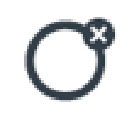Working with the Hardware Configuration Tab

Offline programming of a Hardware Layout Configuration is made in the Controller Template Library.
Configuration Area
In the configuration area, you can either create a layout from scratch or update the existing layout extracted from your controller.
Extract | Updates the hardware layout configuration according to the hardware connected to the controller. |
Zoom in | Zooms in on the layout. (Ctrl + mouse wheel forward) |
Zoom out | Zooms out on the layout. (Ctrl + mouse wheel backward) |
Fit to screen | Reverts the layout back to a default size. |
Delete | Deletes the selected item. |
Creating Hardware Layout
A new installation of the system does not contain any previous hardware layout configurations. Each time you connect ToolsTalk 2 to a controller, the Hardware layout Configuration is empty. You will need to either create a new configuration, or extract the current controller hardware setup.
To create a hardware layout:
For FlexSystem, start with a carrier (3-slot or 6-slot) from Tool Box. For the sequence of the channel number, it is recommended to use 6-slot carriers first. For any system with more than two FlexCarriers, start hardware configuration with a 6-slot FlexCarrier.
For Synchronized tightening system, start with a Sync Reference controller from the Tool Box.
Drag a FlexCarrier or a Sync Reference controller to the Drop here area and drop it. Indicators are displayed. You can point to a symbol to get a tooltip .
Drag other products from Tool Box to a target place. When pointing to a target place with a product, the target place will change color:
Red: invalid drop
Blue: valid drop
You can move, copy and remove a single product or a carrier with all its products.
To move, click and drag the product.
To copy, press Ctrl and drag the product.
To delete, choose the product, or hold Ctrl and select many, and then press Delete. A FlexCarrier containing the FlexController can only be deleted when it is the single remaining carrier. A Sync Reference controller with connected Sync Members and tools can only be deleted when it is the single remaining product, or when all other products are deleted simultaneously.
After creation, push the changes to the controller. The hardware deployment status will change after validation.
Extracting a hardware layout configuration
If the Hardware Layout Configuration is empty, a current controller setup can be extracted by using the Extract button.
Select Extract, the Extract Hardware Configuration dialog box opens.
Select OK to extract the current configuration.
After extracting, push the changes to the controller in order to receive status and health. The hardware deployment status will change after validation.
The Extract function is not available when creating a Hardware Layout Configuration as a Template.
Status
When the controller is connected and online, and the hardware layout configuration is in sync with the controller, ToolsTalk 2 will start to receive notifications of changes in the hardware deployment status. Once notified, ToolsTalk 2 will ask the controller for the Hardware measurement data.
To see detailed deployment status and measurement data:
Select the product in the configuration area. Multiple products can be selected by pressing Ctrl and select.
Click on the Status bar to expand the window.
Tips:
The height of panel can be increased by dragging the top border.
To get the latest measurement data, click Refresh.
The details of Health status can be expanded. Select Show only NOK to only view the data with NOK result.
Tool configuration
For each tool, it is possible to select a tool configuration from a list containing all available tool configurations. By default, no mapping of Tool Configuration is made. It is possible to run tools that are not mapped to a tool configuration. In this case, the controller will use an internally created default Tool Configuration without any of the dual transducer functionality enabled.
Inhibit mode
If there is something wrong with the channel (Drive or tool), inhibit mode can be set to continue using your hardware:
False: Channel is running OK.
Report OK: Channel is disabled and reports OK in result.
Report NOK: Channel is disabled and reports NOK in result.
Report No Result: Channel is disabled and do not show up in the result.
Symbols
Symbols indicate status of each product. You can always point to each indicator to get a tooltip.
| Warning |
| Not expected |
| OK |
| Empty |
| Wrong type |
| Missing |
















































